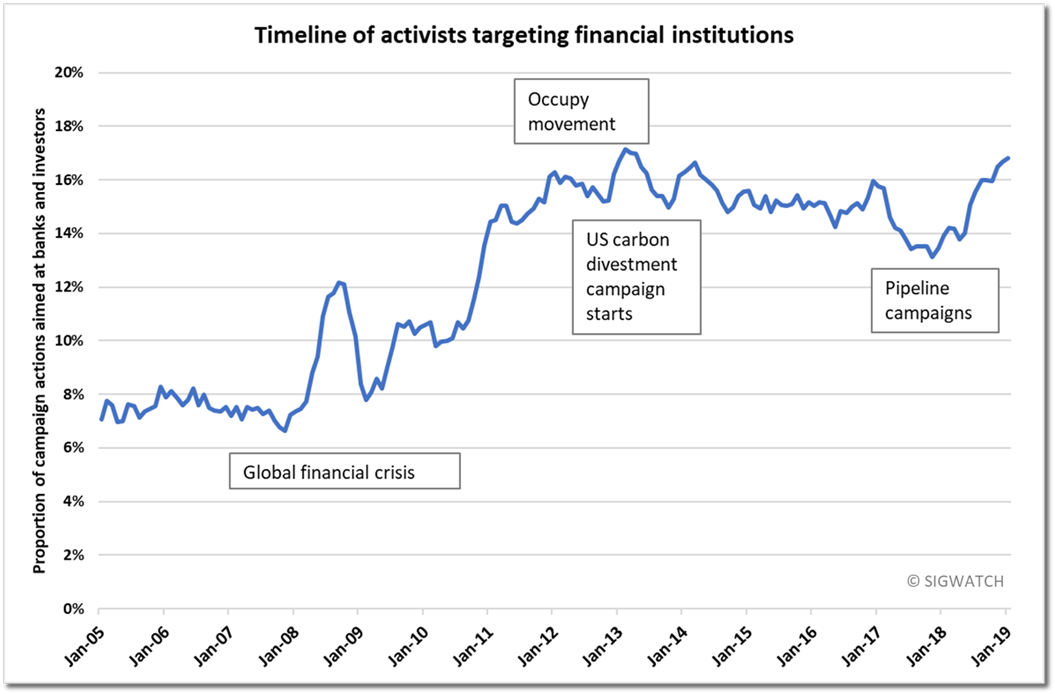Harnessing a new kind of activist

A decade ago, ESG (Environmental, Social, Governance) was a minority interest of specialist investors, but today it is firmly in the mainstream. Non-Governmental Organsiations (NGOs) have not only been instrumental in moving new materiality issues up the investor agenda, they have also ensured that investors take action, and will quickly shame those that don’t. In this article Robert Blood, founder and managing director of SIGWATCH, outlines how NGO campaigns can provide an early insight into the ESG performance of prospective investments, helping investors to identify out-performing and changing firms long before their behaviour begins to affect the annual indexes.
When investors talk about ‘activists’, they usually mean ‘activist investors’: investors who take positions in public companies to push through changes in policy or management. But there is a second type of activist who is just as influential, but operates below the radar of many investors: the campaigning group.
Campaigning groups, aka NGOs (or charities, non-profits), live to change political and public opinion. We are used to seeing them do this with publicity stunts and other tactics to get media attention. If you are an avid reader of the business press, you may also have seen how they put pressure on company managements with embarrassing ‘naming and shaming’ exposés and ‘rank and spank’ comparisons with their peers.
Less visible is the pressure NGOs put on financial institutions and institutional investors to use their influence to make managements change, on threat of divestment. Since the 2008 global financial crisis the level of NGO targeting of financial institutions has more than doubled. Currently there are major campaigns targeting all the leading financial institutions, demanding mass sell-offs of coal and other carbon-related investments and a boycott of energy firms building pipelines to carry oil sands and ‘fracked gas’ (see chart). According to a report published this month by the Institute for Energy Economics and Financial Analysis (IEEFA), every two weeks a bank, insurer or lender is announcing new restrictions on financing coal.
The impact of activist pressure is not confined to the targeted financial institutions. Just last year, Japan’s largest investment fund, Japan Post Holdings, was surprised to learn that Britain’s leading asset manager Legal & General was dropping it from its $6.7 billion Future World index funds, and that L&G funds which still held shares were to be instructed to vote against the re-election of JPH’s chairman. L&G, which had adopted a strong position against carbon after years of pressure from activists, justified the move on JPH’s “persistent inaction” to address climate risk.
The reason that campaigners can have so much influence at all is another unforeseen repercussion of the 2008 financial crisis. Banks’ reputations were in tatters, and being seen to take NGOs and other critics seriously and to be acting on society’s big problems was a no-brainer for management. Their impulse soon began to affect institutions’ investment decision-making – not just if certain classes of assets should be considered off-limits, but whether individual investments and the companies behind them were acceptable. This is ‘due diligence’ on steroids – it was no longer enough to ensure a counterparty was good for the debt, there now needed to be proof that it met increasingly stringent ethical and governance standards and could withstand challenge by an activist group with a hotline to the New York Times. In effect, ‘due diligence’ morphed into ESG screening, and sustainability and governance considerations became part of mainstream investment, rather than being reserved for specialist funds like before.
Another result of the closer relationship between NGOs and institutions is that activists have become very well informed. All major financial institutions have dedicated departments to engage with NGOs and the issues they raise. Their staff are invariably impressed by the expertise of the activists they deal with. Said one: “They do their homework, and sometimes they know more about our investments than we do.”
The good news is that NGOs’ increasing expertise makes them a valuable resource for investors looking for insights into companies. NGO reports and commentaries are used by institutions in rating algorithms and investment profiles, not just to identify bad players, but to spot the good ones too. This is because NGOs have discovered the power of taking a carrot and stick approach to corporations – smack them when they do the wrong thing, but publicly praise them when they do the right thing.
Their discrimination can be used by investors to guide their own decisions. Observing the firms they target, and the reasons for doing so, provides valuable insights which can be turned into positive (eg for impact investing) as well as negative (eg for blacklisting) investment criteria.
Professional investors are right to take the views of activist groups seriously, even if they don’t always agree with them. On many issues, it is indisputable that they make the weather. The changes they push for today will usually occur, sometimes over the long term (climate action), sometimes very quickly indeed (plastic, Genetically Modified Organisms or Chloroflourocarbons). Listen to them and learn which firms they admire or reject. You not only get early warning of emerging issues, you get leading edge intelligence which can be turned into solid investment advantage.
About SIGWATCH
SIGWATCH is a data gatherer and consultancy specialising in NGO campaigns. It tracks the activities of over 9,000 NGOs across the world, identifying emerging issues and quantifying their impact on corporate targets and industry sectors. Financial services firms constitute a third of their clients which also include many of the world’s leading multinationals.
Found this useful?
Take a complimentary trial of the FOW Marketing Intelligence Platform – the comprehensive source of news and analysis across the buy- and sell- side.
Gain access to:
- A single source of in-depth news, insight and analysis across Asset Management, Securities Finance, Custody, Fund Services and Derivatives
- Our interactive database, optimized to enable you to summarise data and build graphs outlining market activity
- Exclusive whitepapers, supplements and industry analysis curated and published by Futures & Options World
- Breaking news, daily and weekly alerts on the markets most relevant to you




